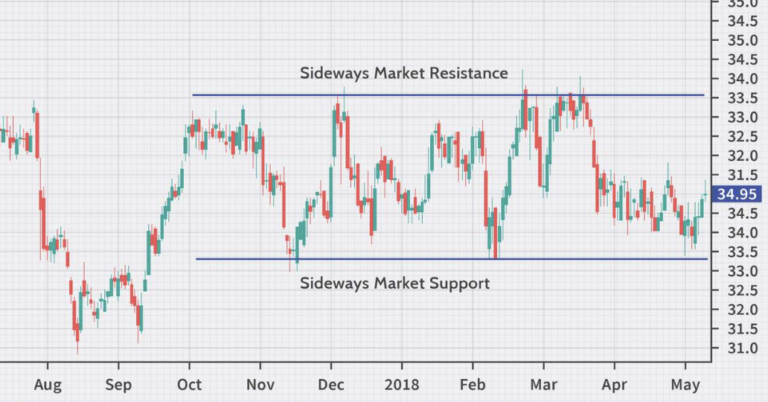
In forex trading, a sideways market occurs when prices move within a tight range without showing a clear upward or downward trend. While traders often focus on trending markets for their potential profits, sideways markets can also present opportunities. Understanding what causes a sideways market is important for knowing how to approach these periods.
Main Causes of Sideways Market
1. Market Consolidation
Consolidation is a key reason for sideways movement. After a strong trend, the market often takes a “breather,” where traders are unsure whether the price will continue in the same direction or reverse. During this time, the price tends to hover within a defined range, creating a sideways pattern.
2. Lack of Major Economic Data or Events
Forex markets are heavily influenced by news and economic data. When there is an absence of significant economic reports or geopolitical events, the market may not have enough momentum to break out of its range. This lack of strong external catalysts can result in prices remaining stagnant, leading to sideways movement.
3. Equal Buying and Selling Pressure
Sideways markets often occur when there is a balance between buying and selling pressure. Neither the bulls (buyers) nor the bears (sellers) have enough strength to push the market in one direction. As a result, prices bounce between support and resistance levels without forming a clear trend.
4. Central Bank Policies
Forex markets are also influenced by central bank policies, such as interest rate decisions. When central banks maintain neutral policies without making significant changes, traders may be hesitant to take large positions, resulting in a sideways market.
5. Low Market Liquidity
Periods of low market liquidity, such as during holidays or after major events, can cause sideways movement. When there aren’t enough market participants trading, the price may move within a narrow range as there’s insufficient volume to drive the market strongly in either direction.
Technical Indicators and Sideways Markets
Technical indicators can help traders recognize sideways markets and decide on the best strategies. Here are some indicators that can be useful:
- Moving Averages: When the moving averages flatten out, it often indicates that the market is consolidating or moving sideways.
- Relative Strength Index (RSI): An RSI hovering around 50 shows that neither buyers nor sellers dominate the market, signaling a lack of clear direction.
- Bollinger Bands: Contracting Bollinger Bands show reduced volatility, which is a common characteristic of a sideways market.
Strategies for Sideways Markets
Even though sideways markets may not offer the same momentum as trending markets, they provide opportunities for short-term traders. Here are some strategies:
1. Range Trading
During a sideways market, traders can buy at support and sell at resistance as the price oscillates between these levels. This strategy can be effective for capturing small profits within a tight range.
2. Wait for Breakout
Although the market may be moving sideways now, it’s often a precursor to a strong breakout. Traders can wait for the price to break above resistance or below support and then enter the trade to catch the next big move.
3. Using Oscillators
Oscillators like the RSI or Stochastic indicators can help traders identify when the market is overbought or oversold in a sideways range, signaling potential entry and exit points.
Conclusion
A sideways market in forex trading can be caused by market consolidation, balanced buying and selling pressure, lack of significant news, and central bank policies. Understanding these factors can help traders identify periods of sideways movement and adjust their strategies accordingly. While trending markets might offer larger profits, sideways markets provide opportunities for traders who know how to operate within a range.